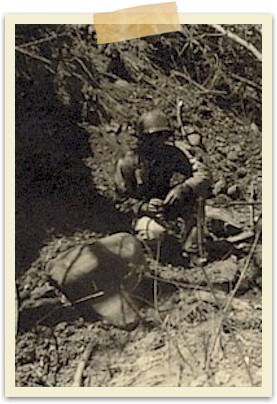|
- 3 -
On
the second night on Corregidor the company had defended the south edge of the
golf course extending west to Battery Wheeler that the 1st platoon had seized
late in the afternoon of February 17. The
first platoon occupying the battery that night had withdrawn a short distance to
the east after the battery's magazine exploded and caused several casualties in
the platoon. The company had
captured Battery Cheney without opposition late in the afternoon of February 18
and the 2d and 3d platoons took positions at the battery.
D Company's command post was in the reinforced concrete end station, B'4,
called "the bunker" by the men in the company.
The 4th platoon was 30 yards east of the bunker with their mortars placed
in a large deep crater. This was
how the company was deployed when the battalion order for the night defense was
given. This, essentially, is how the company would be deployed that
night after the order was given, with
the exception of two squads positioned east of Cheney trail in front of Wheeler
Point.
In
spite of the fact that the 2d Battalion commander had directed that D Company's
right flank was to anchor at the bottom of Cheney Ravine, D Company's right
flank actually began on the hill, where Battery Cheney stood, 500 yards west of
the correct position. This meant there was a 500 yard gap in the regimental
perimeter but in effect the gap was much larger than that.
F Company was to defend the eastern side of Cheney Ravine with their left
flank resting at the bottom on Cheney Ravine tying in with D Company's right
flank. F Company's position
actually began at Battery Hearn 500 yards to the east of where their left flank
should have been. There was no provision made by either company to block Cheney
Ravine, the most obvious route of attack in the 2d Battalion defense zone.
This left a 1000 yard undefended gap across Cheney Ravine on the night of
18 February and neither the regimental nor battalion commander was aware of it.
Had the Japanese chosen to take Black Trail, instead of Beltline Road and Cheney
Trail, as they did, Lieutenant Endo could have marched his force of more than
1500 marines on to Topside parade ground wholly intact. There was little other
than local defense at the Topside Barracks that housed headquarters and service
units. The troop there certainly were in no position to resist a
battalion sized attack at the Topside athletic field, had Endo's marines reached
there unchallenged by going through the gap.
As
it turned out F Company's failure to defend Cheney Ravine would be of little
consequence, but D Company's omission was more serious as the main attack came
up the west side of the ravine on Cheney trail which was D Company's
responsibility. Granted, the 2nd
platoon was blocking Cheney Trail but it was much too far south and allowed easy
access to the high ground at Topside rather than blocking the trail further
north, forcing Endo into an uphill battle to reach the high ground at Topside.
There was no artillery, mortar or machine gun fire planned in the ravine
to deny this obvious attack corridor to the Japanese, who could freely move
around unmolested in the ravine and its trails until they reached the company
position where Cheney Trail entered Topside.
Even had there been artillery or mortar fire on request, D Company could
not have communicated with 2d Battalion Headquarters to request fire (or anyone
else for that matter) because there was no telephone line installed and,
inexplicably, someone had ordered radio silence for the night.
4/
|






